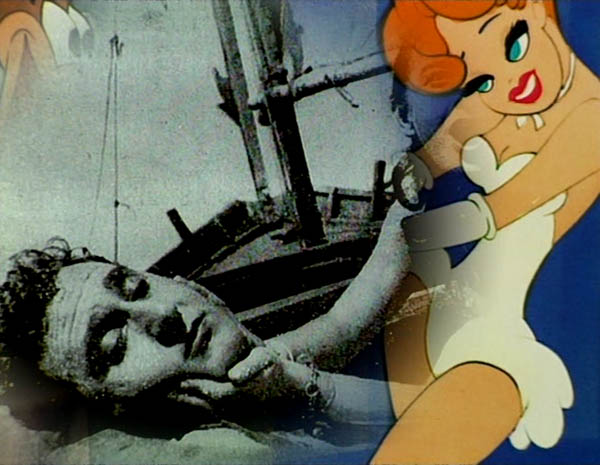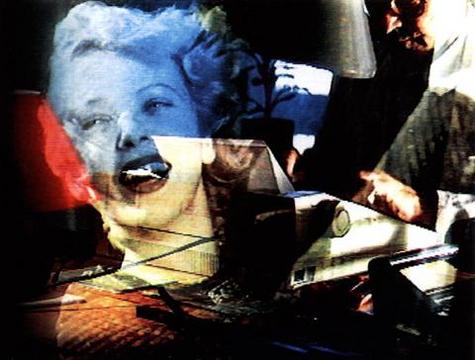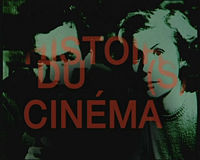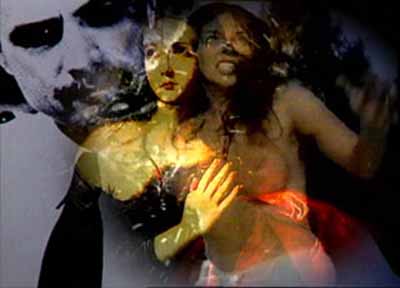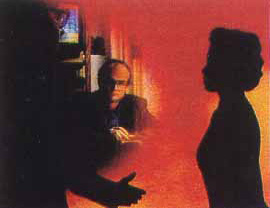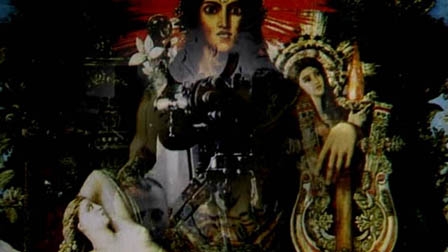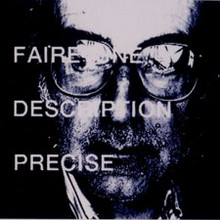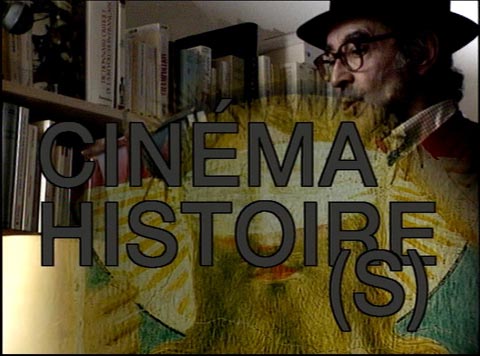This was originally published by the French film magazine Trafic in April 1997. (For a later commentary about episode 4a of Histoire(s) du cinéma, which focuses on Alfred Hitchcock, go here.) –J.R.
Trailer for Godard’s Histoire(s) du cinéma
The following text derives from two particular film festival encounters: (1) a roundtable on the subject of Jean-Luc Godard’s Histoire(s) du cinéma, held in Locarno in August 1995; (2) some time spent with Godard in Toronto in September 1996. I participated in the first event after having seen the first four chapters of Godard’s eight-part video series; unlike the other members of the roundtable — Florence Delay, Shigehiko Hasumi, and André S. Labarthe — I’d been unable to accept Godard’s invitation to view chapters 3a and 3b, devoted to Italian neorealism and the French New Wave, in Switzerland a few days prior to the event. A little over a year later, Godard brought these chapters and a still more recent one — 4a, on Alfred Hitchcock — with him to Toronto, where he was presenting For Ever Mozart, and showed me these three chapters in his hotel room over two consecutive evenings. We also had some opportunities to discuss the series (in English); some of our conversation was recorded, but much of it wasn’t. Then, in mid-December, just as I was beginning to write this article in Chicago and Godard was working on the final episode, he generously assisted me by sending me copies of all the completed chapters to date. (The first two of these chapters are each 50 minutes long; the remaining five are each 25 minutes long.)
At the moment, Histoire(s) du cinéma remains a “work in progress” (1) and the same thing has to be said for this tentative examination, a trailer which can at best be described as fragmentary first impressions by someone who, among other limitations, knows cinema better than he knows French. (And, like most trailers, this is being made while the finished work is still in production.) In the text that follows, all quotations from my conversations with Godard in Toronto are indicated by the abbreviations “JR” and “JLG”. For invaluable assistance throughout this adventure, my particular thanks to Nicole Brenez, Bernard Eisenschitz (the organizer of the roundtable in Locarno), Jean-Michel Frodon, Piers Handling, Bill Krohn, Marco Müller, and Rob and J.K. Tregenza.
Video as a graveyard
JR: Whenever you recount a history, there’s an implication that something is over, and it seems to me that one implication of Histoire(s) du cinéma is that cinema is over.
JLG: The cinema we knew. We also say that of painting.
If one wants to be “up to the minute” about cinema, there’s no cause to be concerned that Histoire(s) du cinéma has been in production for at least nine years — after having been sketched our rather differently, in the form of an illustrated lecture series given in Montreal, a decade prior to that. (2) After all, James Joyce’s Finnegans Wake, the artwork to which Histoire(s) du cinéma seems most comparable, written between 1922 and 1939, was first published in 1939, but if one read it for the first time this year, one would still be ahead of most people in literary matters. For just as Finnegans Wake figuratively situates itself at some theoretical stage after the end of the English language as we know it — from a vantage point where, inside Joyce’s richly multilingual, pun-filled babble, one can look back at the 20th century and ask oneself, “What was the English language? ”– Godard’s babbling magnum opus similarly projects itself into the future in order to ask, “What was cinema?”
Joyce’s province was the history of mankind as perceived through language and vice versa, both experienced and recapitulated through a single, ordinary night of sleep — that is to say, through dreams. Only superficially more modest, Godard’s province is the 20th century as perceived through cinema and vice versa, both experienced and recapitulated through technology — that is to say, through video. Clips and soundtracks are examined and juxtaposed — partly through the ordinary operations of a video watcher (fast forward, slow motion, freeze frame, muting, and programming) and partly through more sophisticated techniques like editing, sound mixing, captioning, and superimposition. Finnegans Wake considers both the English language and the 20th century as something that’s over, and in the same way Histoire(s) du cinéma treats both the 20th century and the history of cinema as something that’s liquidated, finished. (This isn’t entirely a new position for Godard. In January, 1965, responding to a questionnaire in Cahiers du cinéma which inquired, “What do you think of the immediate and the long-range future of the French cinema? Are you optimistic, pessimistic, or do you have a ‘Let’s wait and see’ attitude?”, he replied, “I await the end of Cinema with optimism.” This is one of the reasons why, to my mind, the fact that Histoire(s) du cinéma is a video is of enormous importance, because video in certain respects is the graveyard of cinema, and it’s also the graveyard of the history of the 20th century — or at least of the popular perception of that history. (“Cogito ergo vidéo” reads a title at the beginning of chapter 1b.)
As “unwatchable” and “unlistenable” in many respects as Finnegans Wake is “unreadable,” Histoire(s) du cinéma remains difficult if one insists on reading it as a linear argument rather than as densely textured poetry; in my experience, it is most rewarding when approached in a spirit of play and innocence. It reminds me of a time when I once played a record of Cyril Cusack reading aloud from Finnegans Wake at a friend’s apartment, and it provoked sustained giggles of delight from her two grammar-school children, neither of whom had the same sort of problem with Joyce’s prose encountered by most university professors. As Godard says in chapter 1b, “The cinema, like Christianity, isn’t founded on historical truth. It gives us one account of the story and asks us to believe it.” Histoire(s) du cinéma is neither cinema nor Christianity, but it asks for a similar act of faith.
It is also, like Finnegans Wake, a work constructed in layers, aurally as well as visually — a dimension made especially evident by the dense weave created by the separate channels of the soundtrack. If you look at the separate drafts and manuscripts of Finnegans Wake, you can see that the work became more and more complex as it developed, and in the same way, if you look at the working notes and treatments of Histoire(s) du cinéma, you can tell that it went all the way from Godard’s view of film criticism during the 70s to something which is perhaps closer to philosophy, or maybe even psychoanalysis. Just as most animated films are constructed in layers over extended periods — with the result that probably the best newsreels and documentaries about certain countries are animated films because they bear the imprints of their own periods through their steady accumulations of thoughts and impulses — Godard’s video needs to be read in relation to its own period of composition (1988-1997), not merely in relation to the preceding periods during this century that it covers.
JLG: For me, the reason why I was not so commercial was that it wasn’t very clear to me whether I was writing a novel or writing an essay. I like both of them, but now, in Histoire(s) du cinéma, I’m sure it’s an essay. It’s easier for me and it’s better that way.
JR: So it isn’t simply a matter of video versus film? JLG: No. But video permits certain things. The sound is the same. The good thing in video, too, is that you don’t have to pay when you use music, as you do in a movie or on TV because of the copyright. For example, in Détective. I used some Bartók music, and the Bartók estate refused permission; we had to change it at the last minute. But I could use the same Bartók music in Histoire(s) du cinéma without asking anyone. [See “Histoire(s) du cinéma as legal and political precedent,” below.]
JR: It seems to me that a different kind of energy goes into your films and your videos. It’s clear, for instance, that Histoire(s) du cinéma couldn’t be a film. Why is this the case?
JLG: Well, I’d say for technical reasons, because video is closer to painting or to music. You work with your hands like a musician with an instrument, and you play it. In moviemaking, you can’t say that the camera is an instrument you play through; it’s something different. And then there’s the possibility of superimposition, which isn’t the same in movies, where it has to go through different technical processes. The image isn’t good enough in video, but it’s easier. You only have two images to work with in video; it’s like having only two motives in music, and the possibilities of creating a relationship between two images are infinite. The big difference is that if you shoot the three stone lions of Eisenstein in video, it can be an entire Warhol movie.
Criticism versus Hommage
A central aspect of Finnegans Wake is the multilingual pun (and it’s important to bear in mind that Histoire(s) is a work in at least seven languages: French, English, Russian, German, Spanish, Italian…and Latin). And a no less important aspect of Histoire(s) du cinéma is the multiple quotation — that is, quoting from different films at the same time, which plays an almost equivalent role.
The notion of multiple film quotation has of course been important for Godard since the 60s. Consider, for example, the degree to which Alphaville (1965) offers a complex critique of the silent German expressionist cinema on many registers at once — not only through the thematic and plastic importance of light and darkness, day and night, but also such quotations (or paraphrases) as the camera’s moving through a hotel’s revolving door (from The Last Laugh), figures clinging to walls like Cesare in The Cabinet of Dr. Caligari, and a brief passage in negative (as in Nosferatu), combined with allusions to later films influenced by expressionism (Akim Tamiroff evoking Mr. Arkadin, Touch of Evil, and The Trial; the flight from the city at the end conceived in relation to Orpheus): in short, an updated version of Lotte Eisner’s The Haunted Screen, but expressed in terms of film rather than prose. Chapter 3b of Histoire(s) du cinéma acknowledges this relationship by superimposing extracts from Fritz Lang’s Destiny over the opening of Alphaville and even tracing certain visual rhymes (such as ones between Lemmy Caution’s cigarette and candles in the Lang film). Yet during my conversation with Godard, I was surprised to hear him say that when he made Alphaville, most of his references to German cinema were made unconsciously; it was only when he looked back at the film years later that he realized what he had done, and chapter 3b — dealing, as it does, with the nouvelle vague—records that discovery.)
Dominating the first four chapters (1a, 1b, 2a, 2b) are the alternating sounds of typing and of film turning on an editing table: staccato and legato, the sounds of Godard’s two activities as a critic. (The style becomes exclusively — and beautifully — legato in 3a, on Italian neorealism, the most moving episode to date.) The continuity between writing and filming is apparent in many respects here, above all in the important role played by The Wrong Man (1956) — the subject of the longest, most serious, and most detailed critique written by Godard for Cahiers du cinéma (3) — in episode 4a, devoted to Hitchcock, which shows Godard coming full circle back to the preoccupations of his writing forty years ago. Insofar as Godard, like Rivette, has remained a film critic throughout most of his career as a filmmaker, it is important to clarify how methods of quotation, paraphrase, and allusion, unlike those of practically every other filmmaker, generally remain critical. When Allen, DePalma, Scorsese, and Tarantino echo shots or sequences from other filmmakers, the gesture is always one of postmodernist appropriation, not one of critical transformation, and the same thing can be said about the hommages of (among others) Truffaut and Bertolucci. (For me, the only time when Truffaut as a filmmaker continues to function as a critic is in the powerful act of self-criticism implied in The Green Room [1978] regarding the morbidity and rigidity of la politique des auteurs as a personal system.) When Rivette literally quotes the Tower of Babel sequence from Metropolis in Paris Belongs to Us, thereby criticizing the metaphysical presuppositions of his characters, or when Resnais virtually duplicates a sequence of shots from Gilda inside Delphine Seyrig’s room in Last Year at Marienbad, thereby locating the romantic mystifications of Robbe-Grillet within the even larger romantic mystifications of Hollywood, a certain kind of critical commentary is taking place, even if it’s only implied in the second instance. The same process is at work on a much more elaborate scale in Celine and Julie Go Boating, when Rivette takes the critical discoveries of doubling in Hitchcock, made by Truffaut in relation to Shadow of a Doubt (“Skeleton Keys” — a major piece from 1954 inexplicably omitted in both volumes of Truffaut’s criticism in English, but available in Film Culture no. 32, Spring 1964, and Cahiers du Cinema in English no. 2, 1966) and by Godard in relation to The Wrong Man (translated without its original title, “The Cinema and its Double,” in Godard on Godard, New York: Da Capo, 1986, 48-55), and then applies these principles to the same evolving “double” structure of his own film, doubling shots as well as scenes. But the same thing obviously can’t be said for Allen and DePalma appropriating the baby carriage from Potemkin in Bananas and The Untouchables, for Schrader and Scorsese using part of the plot of The Searchers in Taxi Driver, for DePalma borrowing a 360-degree dolly around a kissing couple (along with Bernard Herrmann) from Vertigo to use in Obsession, for Tarantino getting Uma Thurman in Pulp Fiction to imitate Anna Karina’s dance around a pool table in Vivre sa vie, or, for that matter, Rivette dressing Juliet Berto and Dominique Labourier in black tights à la Musidora when they steal a book from a library in Celine and Julie Go Boating.
Part of Godard’s critical activity is classification, which comes into play whenever multiple quotation is employed. Made in USA is full of combined references to violent noir thrillers and animated cartoons, some contained in the dialogue (“a film by Walt Disney, but played by Humphrey Bogart”, “Walt Disney plus blood”), some contained in the colors and iconography, some contained in the performances (Laszlo Szabo imitating Tweety Pie), and some even contained in the names of characters, so that the surname of Jean-Pierre Léaud’s character, Donald, might well be either “Duck” or “Siegel”. The murder of a provincial aunt in Weekend evokes the knife thrusts in Psycho and the incinerator used for burning a corpse in Monsieur Verdoux, two films that associate murder with business; and Les Carabiniers teems with references to war films ranging from Walsh’s What Price Glory? to Sirk’s A Time to Love and a Time to Die.
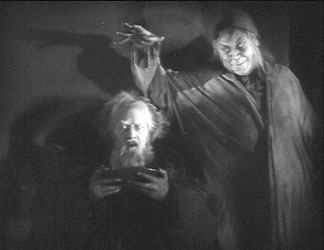

The same tendency is carried over directly into Histoire(s) du cinéma. Early in chapter 1a, Godard creates a very beautiful montage by intercutting clips from Murnau’s Faust (Mephistopheles greeting Faust at a crossroads) and Minnelli’s The Band Wagon (Cyd Charisse dancing around Fred Astaire in a bar during a production number) while we hear portions of both Beethoven’s Tenth Quartert and the incantatory narration in Last Year at Marienbad in which the hero speaks to the heroine about how she hasn’t changed. Leaving aside Beethoven, it appears that what we have here are three very different versions of the Faust theme involving hypnotic persuasions, invitations into a world of narcissistic fantasy and self-fulfillment. (The dance number in The Band Wagon, one should recall, is part of a stage musical based on Faust, and Charisse dancing around Astaire in a gangster setting is explicitly linked in the editing to Mephistophocles tipping his hat to greet Faust.)
Other multiple quotations of this kind in the early chapters of Histoire(s) du cinéma include such pairings and clusters as the burning of a witch from Dreyer’s Day of Wrath with Rita Hayworth singing “Put the Blame on Mame” in Gilda (followed by allusions to Witchcraft Through the Ages and Ordet, accompanied by dialogue from a film by John Garfield which I can’t identify); the wicked witch from Disney’s Snow White and the Seven Dwarfs with Bernard Herrmann’s Psycho score; D.W. Griffith, Charles Chaplin, Mary Pickford, and Douglas Fairbanks posed together, identified collectively as “Les Enfants Terribles”; the title I Confess with a still from Pickpocket; Elena et ses hommes with “The Night They Invented Champagne” from Gigi, along with erotic sequences from Silk Stockings and Prénom: Carmen, a photograph of Renoir, and a recording of Renoir speaking.
For Godard, the functions of critique and hommage sometimes overlap: in JLG/JLG and in 2 x 50 ans de cinéma français, it is the latter that predominates, even if the deliberate obscurity of certain references in 2 x 50 ans arguably corresponds in certain cases to a particular critical position. (Characteristically, the touching hommage to Roger Leenhardt in the latter — included not in the Diderot to Daney “pantheon” of writers at the end but much earlier, in what is probably the longest clip in the video — is an unattributed extract from Godard’s own The Married Woman.) There is nothing critical about the groupings of stills and portraits in chapter 1a organized around Eisenstein, Welles, Renoir, and Vigo. But an hommage becomes a critique when it defamiliarizes the material, as the Russian formalists might say — which is why the clips in Histoire(s) that tend to be the most mysterious are usually the ones that one recognizes: James Gleason drunkenly rocking back and forth in a rocking chair in The Night of the Hunter (in chapter 3a — an image recalling Lillian Gish in Intolerance, reminding one of how closely Laughton studied Griffith), the screen test on board a ship in King Kong (recycled repeatedly throughout the series). And when Godard wants to cite a particular director within a given context, his choices are sometimes anything but obvious. In 3a, which details some of the sources of the New Wave (“It’s all over the place,” I recall Godard saying to me in Toronto, “because the New Wave was all over the place”), the major reference to Robert Aldrich is a pair of female wrestlers at work in …All the Marbles, and the major reference to Preston Sturges is by way of The Beautiful Blonde from Bashful Bend….
Hitchcock, master of the universe
JR: Have there been many cases where you can’t acquire the clips you want?
JLG: If I don’t have it, I take another one, and then I tell another story, more or less, with no problem. In the last episode [4b], any shots can be good. I need documentary shots that are both strong and of no importance.
JR: What are for you the main differences between the early episodes and the late ones? JLG: The early episodes are more linked to cinematography; the last ones are more about the philosophy of what cinema is in this century, more about what is specific to cinema.
JR: You certainly concentrate more on specific film subjects in 3a, 3b, and 4a: neorealism, la nouvelle vague, and Hitchcock.
JLG: I put in Hitchcock because during a certain epoch, for five years, in my opinion, he really was the master of the universe. More than Hitler, more than Napoleon. He had a control of the public that no one else had.
JR: What about Ronald Reagan? Didn’t he have the same control?
JLG: No, because Hitchcock was a poet. And Hitchcock was a poet on a universal level, not like Rilke. He was the only poet maudit to have a huge success. Rilke wasn’t one, Rimbaud wasn’t. He was a poet maudit for everyone; Notorious wasn’t like James Joyce. I remember André Bazin was very angry with us. And something which is very astonishing with Hitchcock is that you don’t remember what the story of Notorious is, or why Janet Leigh is going to the Bates Motel. You remember one pair of spectacles or a windmill — that’s what millions and millions of people remember. If you remember Notorious, what do you remember? Wine bottles. You don’t remember Ingrid Bergman. When you remember Griffith or Welles or Eisenstein or me, you don’t remember ordinary objects. He is the only one.
JR: Just as with neorealism, as you show, you remember only people.
JLG: Yes, it’s the exact contrary. You remember feelings, or the death of Anna Magnani. It’s very clear.
JR: It was a very important moment for me in 4a when you included almost an entire sequence from The Wrong Man, of Henry Fonda alone in his jail cell, because that linked your video with one of your major critical pieces for the Cahiers. By contrast, I don’t recall you including any clips from Bitter Victory or A Time to Love and a Time to Die.
JLG: No.
JR: And it’s interesting that you call Hitchcock the only filmmaker apart from Dreyer who could film miracles, because some people have argued that the miracle in The Wrong Man isn’t believable.
JLG: But it was based on a true story! And Ordet and The Wrong Man were both commercial flops; that’s another connection.
Cinema and the 20th Century
JLG: Everything came from the New Wave. First it was spreading and then it disappeared. That’s why I said to Anne-Marie [Miéville], “At the time of Jean Vigo, it was the same as it is for us now: ‘difficult,’ a flop, no one’s seeing it.” But because of what happened at the time of neorealism and then at the time of the New Wave — because of the theory of all that — attendance went up. And now it’s going down again. It’s always been like that. I say what I mean in the third episode of Histoire(s) du cinéma: it’s evident that movies are capable of thinking in a better way than writing and philosophy, but this was very quickly forgotten. So this is what happened. The New Wave was a miracle. It was a crystallization of what James Agee wrote about. (4) (Compare the following sentence from “Le cinéma et son double”, Cahiers du cinéma no. 72, June 1957: “Once again, Alfred Hitchcock proves that the cinema today is better fitted than either philosophy or the novel to convey the basic data of consciousness.”) [Godard on Godard, translated by Tom Milne, New York: Da Capo, 1986, 50]
In terms of the overall myth of Histoire(s) du cinéma, the cinema and the 20th Century — almost interchangeable in Godard’s terms — are contextualized by two key countries (France and the United States), two emblematic studio chiefs (Irving Thalberg, Howard Hughes), and two emblematic world leaders (Lenin, Hitler); two decisive falls from cinematic innocence (the end of silent film that came with the talkies and the end of talkies that came with video); two decisive falls from worldly innocence (World War I and World War II); and two collective cinematic resurgences that took place in Europe, affecting the moral and aesthetic consciousness of the rest of the world (Italian neorealism and the New Wave). (5)
In chapter 2a, Serge Daney explains to Godard why he is uniquely qualified to recount the history of cinema by coming from the New Wave, which started midway through the 20th century and midway through cinema itself. (Coming midway through Histoire(s) du cinéma, in an episode that concludes the second of four hours, it is an ideally timed moment of stock-taking.) He also stresses the degree to which Godard’s desire to place himself in history is a characteristic French trait. And because “The cinema authorizes Orpheus to turn around without making Eurydice die” (the final title in this chapter, apart from a Latin motto), the implication of many things being almost over — above all, the century and the cinema — establishes the basis for Godard’s extraordinary monologue at the end of 2b, “Beauté fatale,” about cinema itself as an act of mourning.
What is history?
JR: There’s a sequence from Que Viva Mexico in chapter 2a that seems edited in a very Eisensteinian way. Is this editing yours?
JLG: No, it’s Marie Seton’s. In a sense, I think I’m virtually unassailable in Histoire(s) du Cinéma. I used Marie Seton’s because it was the very first one that we knew about, Time in the Sun. Jay Leyda had not yet done his critical work on it, and I never saw that version; it was the kind of movie we never saw. And so, since I was speaking of the New Wave, it has to be Marie Seton. Because Marie Seton belongs to the same epoch as Jean-Georges Auriol, who was so fond of Marie. If it was another episode, maybe I would have edited the footage myself. I’m not ashamed to re-edit another filmmaker.
How much of a historian is Godard? A complex question, almost as complex in a way as asking the same question about Joyce. “That which has never taken place is the work of the historian,” reads an early title in chapter 2a. Much of Godard’s work since the 80s is concerned with amnesia — a subject that becomes especially important in his King Lear (1987) and 2 x 50 ans de cinéma français — but there are times when Godard’s own amnesia seems as much of an issue as everyone else’s.
Case in point: The epigraph of Contempt (1963), attributed to André Bazin and appearing also in the beginning of episode 1a and in For Ever Mozart, is, “Cinema substitutes for our gaze a world that corresponds to our desires.” But it appears that neither the quotation nor the attribution is correct. A more probable source is a sentence that appears in “Sur un art ignoré” by Michel Mourlet (Cahiers du cinéma no. 98, août 1959, 34, nine months after Bazin’s death): “Since cinema is a gaze which is substituted for our own in order to give us a world that corresponds to our desires, it settles on faces, on radiant or bruised but always beautiful bodies, on this glory or this devastation which testifies to the same primordial nobility, on this chosen race that we recognize as our own, the ultimate projection of life towards God.”
Another example: in excerpts from a document (published in English in Jean-Luc Godard: Son + Image, edited by Raymond Bellour with Mary Lea Bandy, New York: The Museum of Modern Art, 1992, 132) written and assembled by Godard alongside Histoire(s) du cinéma — an early version of a book scheduled to be published by Gallimard at the same time that the complete video series premiered in Cannes — Godard incorrectly describes Howard Hughes as the “producer of Citizen Kane”.
False quotations and false attributions are, of course, quite common in film criticism. Although Godard himself is correctly credited for having made the famous remark, “Tracking shots are a question of morality,” what is almost invariably omitted from this attribution is that Godard was merely inverting a sentence by Luc Moullet published four months earlier: “Morality is a question of tracking shots.” (Moullet’s sentence appears in “Sam Fuller: In Marlowe’s Footsteps” [ March 1959], translated in Cahiers du Cinéma: The 1950s (Cambridge: Harvard University Press, 1985, 148]; Godard’s sentence appears in a July 1959 roundtable on Hiroshima, mon amour, translated on page 62 of the same volume.) Godard’s version of the epigram is perhaps the more memorable of the two, and it’s theoretically possible that Moullet was only paraphrasing something he heard Godard say at an earlier date. For that matter, Mourlet may (or may not) have been paraphrasing something he might have read or heard from Bazin. The point, in any case, is I don’t know, and the history of film and film criticism abounds with such cases of not knowing. A surfeit of not knowing, however, produces only confusion, and the advantage of false or at least dubious quotation and attribution in this case is that they produce some form of history — or, more precisely, histoire(s)….Is it true, as Godard asserts in 2b, that F.W. Murnau and Karl Freund invented Nuremberg lighting while Hitler still couldn’t afford a beer in a Munich café? Whether true or not, it is certainly a form of history, poetry, and criticism, transforming the object of our gaze.
Puns, for Joyce, are the stuff of dreams, and the same could be said for the multiple quotations of Godard: neither is a proper vehicle for history in any rigorous way, but they both reflect history and cast reflections upon it. (There is no precise equivalent to Vico or a theory of circular history in Histoire(s) du cinéma as there is in Finnegans Wake, but the sense of eternal recurrence is very much present in the repetition of various images and phrases.) After all, “History,” said Stephen Dedalus in Ulysees, “is a nightmare from which I am trying to awake.” And the history from which Histoire(s) du cinéma is trying to awake is also a history of science, painting, literature, and music — in short, the same history of modernism that Joyce is also trapped inside, offering a surfeit of significations that film scholarship will be decoding in the century to come. (If we have film and if we have scholars, that is; the implication of Daney’s discourse is that we won’t.)
In dreams begin responsibilities
In Godard’s first phase as a filmmaker (roughly 1959-1968), he functions very much as a historian of the present, literally as well as figuratively — a major dimension of his work that becomes diminished once he forsakes Paris for Grenoble and then rural Switzerland. Arguably, it is only when Switzerland functions as Switzerland in his films of the 90s, as in Nouvelle vague (1990) — or when Germany functions as Germany in Germany Year 90 Nine Zero (1991) — that the Godardian sense of both place and period survives intact; in Hélas pour moi (1993) and, even more, For Ever Mozart (1996), by contrast, there is a sense of relative “placelessness” that also seems to locate both films outside of time, in spite of their many topical references. Interestingly enough, this ceases to be a problem in his videos (in Histoire(s), for instance, the only ongoing “place” that counts in cinema, not Switzerland), and perhaps for this reason, it has recently been in video, not film, that he functions most comfortably as a historian.
This historical impulse can already be seen in a mocking juxtaposition of shots reportedly eliminated by the French censors from Breathless (1960) -– a cut from Charles de Gaulle in a car following Dwight D. Eisenhower in a car in a procession down the Champs-Elysées to Jean-Paul Belmondo following Jean Seberg down the sidewalk. This conflation of the sexual with the military/political rhymes with the rude simile proposed by Godard in chapter 1a of Histoire(s) du cinéma over a frenzied montage synthesizing a musical number (“Ladies in Waiting”) from Les Girls, Max Ophüls, Molière, Madeleine Ozeray, Louis Jouvet, and even Bogart: “1940, Geneva, L’École des femmes, Max Ophüls. He falls upon Madeleine Ozeray’s ass just as the German army takes the French army from behind.” The reference is to Ophüls’ unfinished filming of a stage performance of the Molière play, and the significance here is again the simultaneity of what’s happening in cinema and what’s happening in the world outside — a point made equally in the same chapter when Godard rhymes a figure in a skeleton costume at a masked ball in The Rules of the Game (1939) with concentration camp victims, or when, in 3a, he links Elina Labourdette’s penultimate line in Les Dames du Bois de Boulogne (1945), “Je lutte” (“I struggle”), to de Gaulle saying to the free French, “We must struggle”, around the same time. The latter linkage has prompted Godard to call Les Dames du Bois de Boulogne the “only” film of the French Resistance, and even if one chooses to reject such a notion, it becomes possible to appropriate it as a critical insight into the early films of Robert Bresson. For it might be argued that some of Bresson’s most important identifying traits as a filmmaker — such as his uses of offscreen sounds to replace images, or the sense found in all his films of souls in hiding, of buried identities and emotions — might be traceable in part to his nine months (1940-41) in a German prison camp and his subsequent experience of the German occupation of France. This applies not only to his masterpiece about the French Resistance, A Man Escaped (1956) — where the sounds of the world outside Fontaine’s prison cell create as well as embody his very notion of freedom — but also to his other early features. Such an interpretation can of course be debated, but it seems to me a far more fruitful approach to Bresson’s style to see it growing out of concrete and material historical experience than to treat it as a timeless, transcendent, and ultimately mysterious expression of abstract spirituality. (Judging from Michel Ciment’s recently published interview with Bresson in Positif no. 430, Decembre 1996, Bresson may share this bias himself: “To treat me like a Jansenist is insane: I’m the opposite of a Jansenist, I search for an overall impression. When I’m on the grand boulevards, I ask myself straightaway, ‘What sort of impression do they make on me?’ And in fact this impression is of a jumble of legs which makes a sharp sound on the pavement. I’ve tried to render this impression with sound and image.”) And Godard’s historical linkage, without actually propounding this critical argument, at least points us in the proper direction. It’s a way of saying that cinema is concerned with the world, not with an alternative to it, and that cinema belongs to the world, including us.
Histoire(s) du cinéma as legal and political precedent
JR: There’s an important legal precedent in the way Histoire(s) du cinéma uses clips. There are some other very interesting recent videos that use clips critically — Mark Rappaport’s Rock Hudson’s Home Movies and From the Journals of Jean Seberg and Thom Andersen and Noël Burch’s Red Hollywood — without acquiring rights. It’s usually impossible to get rights for the clips in works of this kind, so they’ve all been made outside the system.
JLG: Gaumont, which owns Histoire(s) du cinéma, probably has a big worry now, because if it’s me, it’s one thing, but if it’s Gaumont…The first two episodes were shown on five separate European TV channels, so it is a precedent, because if it wasn’t me with the friendship of Gaumont, no other producer would have done it due to the rights problem. But for me there’s a difference between an extract and a quotation. If it’s an extract, you have to pay, because you’re taking advantage of something you have not done and you are more or less making business out of it. If it’s a quotation — and it’s more evident in my work that it’s a quotation — then you don’t have to pay. But it’s not legally admitted in pictures.
JR: Yes, but it also isn’t legally acknowledged that films and videos can be criticism.
JLG: It’s the only thing video can be — and should be.
One could argue that the decline of film criticism in recent years — observable in the habits of most newspaper and magazine editors in both Europe and North America as well as most films academics in North America — is not so much a reflection of the changing tastes of audiences (as these editors and academics often insist) as it is the power of multicorporations to eliminate everything that interferes with their promotion. Just as the so-called “American independent” filmmakers promoted by the Hollywood studios via Sundance usually means the filmmakers who have lost their independence, “film criticism” in the mainstream now refers mainly to promotional journalism; true independents and critics have to function in the margins. On more ways than one, the traffic is moving underground.
Philosophically speaking, Histoire(s) du cinéma is a dangerous work because it dares to raise the issue of whom cinema, film criticism, and film history belong to. Truthfully, they belong to everyone today with a VCR [or DVD player], but contractually, they belong to the state, and the state today — especially from the standpoint of an American like myself — is Disney. It is Disney and its client states such as Miramax that set our cultural agendas and rewrite our official film histories and critiques via the mass media. By writing his own film history and criticism on video, using means that are readily available and relatively inexpensive, Godard is proposing a direction that filmmakers and video artists everywhere could explore with benefit — the direction of appropriation, a movement already inaugurated by the critical and historical reappraisals of the New Wave, and continued in Histoire(s) du cinéma by other and more subterranean means, such as poetry and autobiography. Recalling Paris Belongs to Us, Jacques Rivette’s first feature, I propose a slogan: Paramount belongs to us.
Endnotes
1. When Godard completed this work in 1998, he revised all the episodes apart from the last, based on the film clips to which Gaumont couldn’t acquire the rights. In 1999, the soundtrack to the series was issued on CDs by ECM along with an abbreviated version of Godard’s text in English, French, and German and some frame enlargements in four books. My text here, minus the final section, was included in English in the fourth volume. I still don’t know whether Godard himself performed this censorship, presumably on the pretext that this section was now “out of date” [2009]
2. See Introduction à une véritable histoire du cinéma by Jean-Luc Godard, Paris: Editions Albatros, 1980. One should also note that some of Godard’s other recent videos -– Les enfants jouent à la Russie (1993) and 2 x 50 ans de cinéma français (1995) — might be regarded with profit as “annexes” to Histoire(s) du cinéma.
3. See my article “Le vrai coupable: two kinds of criticism in Godard’s work,” Screen, vol. 40 no. 3, Autumn 1999, 316-322. [2009]
4. For example: “The films I most eagerly look forward to will not be documentaries but works of pure fiction, played against and into, and in collaboration with unrehearsed and uninvented reality.” (Agee in The Nation, January 25, 1947.)
5. A skeptical afterthought: “Missing from this highly skewed view of the world is practically all of Asia and the Pacific, the Middle East, and Africa — not to mention most experimental cinema made everywhere. At least two major Japanese filmmakers, Kenji Mizoguchi and Yasujiro Ozu, are given some recognition, and a still from Souleymane Cissé’s Yeelen is seen, but the latter is the only fleeting allusion to African cinema, and the cinemas of Iran, India, and Australia (for instance) can’t be said to exist at all in this scheme. Even worse, adding a certain amount of complacent and (at times) neocolonialist insult are the references to Fritz Lang’s The Indian Tomb, George Cukor’s Bhowani Junction, and Marguerite Duras’s India Song that seemingly ‘replace’ Indian cinema (three great films, to be sure — but hardly adequate substitutes) and an even more dubious evocation of other ‘darker’cultures in which Philippe Garrel’s Marie pour mémoire, Jean Gremillon’s Lumière d’été, John Coltrane’s jazz piece ‘Africa,’ White Shadows, Captain Blood, Glauber Rocha’s Antonio das Mortes, and Jean Rouch’s Moi, un noir are invited to rub shoulders with Yeelen.
“To be fair, Godard was among the first Europeans who recognized the importance of Abbas Kiarostami, and this recognition took place while he was still working on Histoire(s) du Cinéma. Nevertheless, it’s clear and perhaps also understandable according to his ‘closed book’ policy that he decided Kiarostami played no role in the (hi)story he had to recount. Here is only one clear instance of a collision between history as it’s written and the history that remains to be told, and it points to a much wider weakness and absence in much contemporary film criticism that attempts to generalize about the state of the art, past and present.” (Taken from a 2003 essay, “Godard’s Myth of Total Cinema,” commissioned by the Rotterdam International Film Festival.)
— Trafic no. 21, printemps 1997; revised and updated, January 2009

